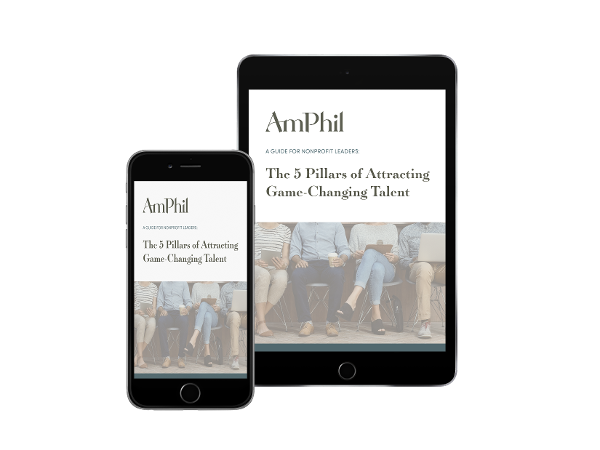
Does the prospect of hiring for your nonprofit or mission-driven organization stress you out? If so, you aren’t alone. The process can be confusing and daunting, but it doesn’t have to be. Many years of experience in the talent recruitment game have given us a list of hiring best practices that will help you reframe commonly held hiring fears, identify growth areas, and transform your organization’s talent recruitment and interviewing practices.
1. Reframe Your View of Hiring
We all have tasks at work we would rather avoid, like cleaning up a messy spreadsheet, deciphering email threads the length of the Dead Sea Scrolls, or engaging in what technically qualifies as water cooler conversation with the office dud (sorry, Jim!).
Luckily, your talent search and hiring process doesn’t have to make that list.
Viewing hiring as tedious, or even as filler work, is the wrong approach.
Hiring is an opportunity to bring in the next great champion of your mission.
Take your time identifying goals and get excited about how your next hire could impact your organization.
Crafting the ideal job description, interviewing candidates, and making decisions can be unpredictable, but by properly emphasizing the importance of this work you set yourself up for success.
2. Dive into the Job Description
It’s important to do an in-depth review of what your organization really needs from a position before you put pen to paper. This may seem obvious, but (especially when backfilling a position) it’s too easy to spit out a rote description of tasks typically associated with the job title.
Get specific and tailor the role for your organization, and you will create an accurate, thorough description that brings in the best candidates.
It ensures the new hire is well-prepared for their duties and allows staff to zero in on gaps in the current workflow.
If this seems daunting, it can be extremely helpful to hire a recruiting firm that’s familiar with your organization’s market and can provide a more thorough review than would be possible internally.
3. Be Human
AI has its place, but it's not in the hiring process. Remember: You aren’t looking for a robot. You’re seeking someone who can engage with your mission and take your organization to the next level. Keep this in mind as you commence your talent search.
Unless you strike gold like the original '49ers, there’s rarely one candidate who's an obvious fit after one impersonal interview.
Try to get to know your top candidates as people, not just as worker bees.
Good hiring isn't just about reading line items on a résumé; it's about finding a person who will mesh with your mission and staff on a personal level.
4. Be Wary of Dazzle
People with a knack for performance are engaging, charming, and radiate confidence in an interview. Sometimes that is accompanied by excellent real-life skills . . . and sometimes, the shine dulls in a hurry once their feet hit the ground. That’s showbiz, baby.
Learn to differentiate between a great fit and a great interviewer.
The stars may align to give you both, but often your real diamonds in the rough are mediocre interviewers.
The ideal candidate combines hunger for the job with intelligence and humility.
5. Identify the Savvy Decision-Makers
Make sure your hiring committee is made up of discerning people with the information they need to make a good decision. Too few decision-makers can fail to address crucial areas, while too many cooks in the kitchen make for a lack of accountability (not to mention a tedious process for interviewers and candidates alike).
Get feedback from people with experience and identify exactly who “owns” the decision and can take accountability.
Remember that a trusted colleague providing input is not the same thing as making the final decision.
6. Invest, Invest, Invest
Investing in hiring from the first moment is a vital step toward ensuring future success and excellence. It’s easy to spot an organization that doesn’t prioritize staffing —just look for frantic hiring practices and high turnover rates.
We highly recommend identifying the gaps in your organization’s staffing and how to remedy them during your strategic planning. That way you can start strong and have a solid understanding of the human and financial resources necessary to meet your needs in the coming year(s).
Talent recruitment is not the place for nonprofits to cut corners, a piece of advice any organization with a series of bad hires would echo.
7. Take Time to Improve
Any hiring committee or manager is bound to make a misjudgment eventually. Instead of barreling ahead after a mistake, it’s a great idea to engage in self-reflection.
What are my (or the hiring committee’s) strengths and weaknesses, and how have those informed which candidates we’ve chosen?
Where can the process be tinkered with, based on what we’ve learned? These are excellent questions to ask.
In Conclusion . . .
Hiring can be uncomfortable, but the human aspect of the process can be extremely rewarding for both the organization and the hiring manager. Recruiting talent is your chance to engage with people on a deeper level and achieve your organization’s mission in new and unexpected ways.


